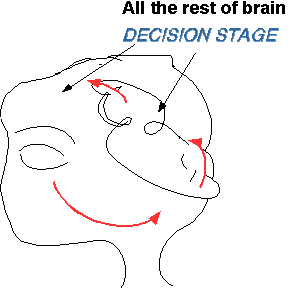

Assumptions are necessary to get from the outputs of the processes of interest to the responses of the observer. We will refer to these assumptions as describing "the decision stage."
Multidimensional signal detection theory deals with questions of how outputs from multiple analyzers (channels, pathways, mechanisms ....) enter into this decision.
In behavioral studies of visual perception, assumptions are necessary to specify the relationship between the outputs of the visual processes nominally being studied and the responses of the observer. We refer to these assumptions, following convention, as "the decision stage". This term should not be taken to imply conscious decision-making like that in more complex situations, however.
The usual assumptions about the decision stage are very simple compared to the large amount of brain that they are the "stand-in" for.
Papers are frequently written as if no such assumptions were necessary. I am reasonably certain that, when this happens, the authors end up fooling either themselves or the readers, or both.
In the summaries of our research on these web pages, the "decision stage" is explicitly mentioned in several places, which are linked here. (Our assumptions about the decision stage are described in the corresponding publications at greater, perhaps tedious, length.)
The decision stage (multi-dimensional signal-detection theory) in models of near-threshold detection and identification experiments on the Multiple-Analyzers page
The decision stage in models of perceived threshold-segregation experiments (on Complex Channels page , introduced as part of Simple-Channels model)
A brief mention of the decision stage (multi-dimensional signal-detection theory) in models of Detection and Identification of second-order textures.
The decision stage in models of light-adaptation dynamics experiments (about "ideal" vs. "peak-trough" observers and how they interact with temporal vs. spatial filtering of quantal noise, including the difference between optical blur and neural filtering)